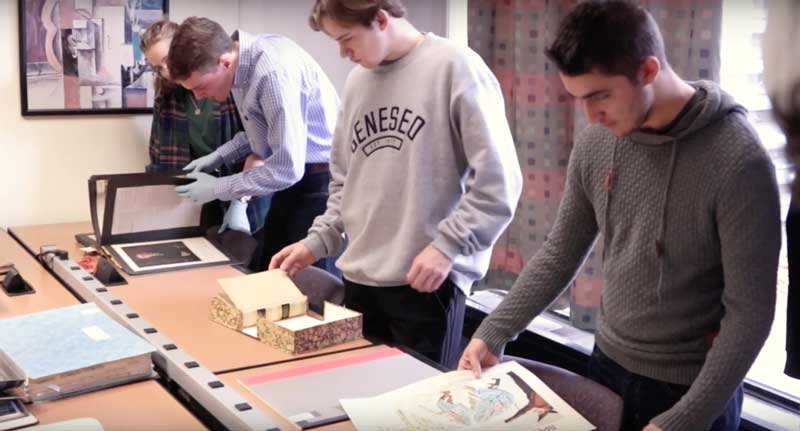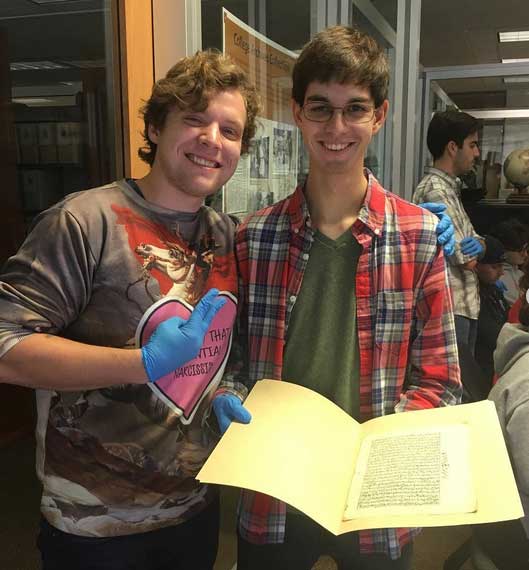
History students working with Special Collections material (photo provided).
SUNY Geneseo students can gain first-hand research experience with primary source materials, thanks to the college’s Special Collections. The Special Collections archive spans hundreds of years and encompasses books, papers, manuscripts, maps, photographs, and miscellaneous artifacts.
“Working with primary source evidence can be engaging and inspiring,” says Joe Cope, professor of history and special assistant to the provost. “It’s a chance to connect directly with people in the past by interacting with the documents and artifacts that they created or worked with.”
The Special Collections extend far beyond the college’s historical archive, explains Liz Argentieri, Special Collections librarian. The eight collections include local history papers and photographs about the Genesee Valley and its early settlers, as well as more esoteric materials: writings on Henry David Thoreau, recordings of traditional music and dance in New York State, and the X Collection, a resource containing rare, fragile, or valuable books and other objects.
“Portions from all the collections have found their way into Geneseo’s classes and help enhance the coursework,” says Argentieri. “The items don’t circulate, so students come into the Fraser Hall Library to get up close and personal with the materials.”

There’s a thrill that comes from touching something that’s centuries old, says Yvonne Seale, an associate professor of history whose students use the collections regularly. “But having the opportunity to study a book or a manuscript closely and figure out something that no researcher has before is a great way of sparking a budding researcher’s imagination.”
Students in Seale’s course Hacking the Middle Ages, a research skills seminar, have joked that the course turned into CSI Geneseo. While digitizing and cataloging archival materials, they discovered and corrected errors made by an original cataloger.
“Figuring out what happened in the past shifts from being an intellectual exercise to an active endeavor in which they are involved,” says Seale.
Special Collections materials are surprisingly wide-ranging. Devin Prine ’23, a sustainability studies major from Avon, NY, accessed first-hand accounts of lion hunts in the mid-1800s for a paper on the impact and ethics of big game hunting. Matthew McMullan ’25, a history major from Wading River, NY, discovered a book on the causes of the Mexican-American War, published circa 1853, that he needed for a historiography paper.
“Working with digitally uploaded sources can change the tone and structure of my writing,” McMullan says. “The ability to read an original edition of the book helped shape my paper and strengthen my analysis of the source.”
Knowing how to work with primary source materials is a core skill for historians. Still, the skill translates to many other disciplines as well, and the collection gets use from a number of departments. Art history students recently conducted in-depth research on Brodie Hall’s architect Edgar Tafel, and associate professor of English Ken Cooper collaborated with Argentieri to create the Open Valley course, a digital humanities project interested in ecology.
Student access to the collection supports the college’s integrative and applied learning graduation requirement, says Cope, which facilitates hands-on work and research outside of the classroom, including internships with local museums, local historians’ offices, and cultural centers.
“This research also gives students a sense of the skilled and valuable work of preserving historical objects, cataloging knowledge, and making it searchable and accessible for other people,” says Seale. “For students who go on to careers in data analysis, library and archival studies, or non-profit administration, this is a really vital understanding.”
